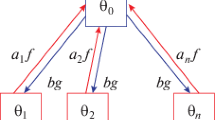Abstract
Advances in understanding the neuronal code employed by cortical networks indicate that networks of parametrically coupled nonlinear iterative maps, each acting as a bifurcation processing element, furnish a potentially powerful tool for the modeling, simulation, and study of cortical networks and the host of higher-level processing and control functions they perform. Such functions are central to understanding and elucidating general principles on which the design of biomorphic learning and intelligent systems can be based. The networks concerned are dynamical in nature, in the sense that they “compute” not only with static (fixed-point) attractors but also with dynamic (periodic and chaotic) attractors. As such, they compute with diverse attractors, and utilize transitions (bifurcation) between attractors and transient chaos to carry out the functions they perform. An example of a dynamical network, a parametrically coupled net of logistic processing elements, is described and discussed together some of its behavioural attributes that are relevant to elucidating the possible role for coherence, bifurcation, and chaos in higher-level brain functions carried out by cortical networks.
Similar content being viewed by others
References
Abeles, M.: 1982, Local Cortical Circuits, Springer, New York. Also, Corticonics: Neural Circuits of the Cerebral Cortex, Cambridge Univ. Press, NY, 1991.
Annios, P. A. et al.: 1970, J. Theoretical Biology 26, 121–148.
Bertille, J. M. and Perez, J. C.: 1990, in: Proc. IJCNN'90, L. Erlbaum Associates Publishers, Hillsdale, NJ, pp. 361–364.
Bosch, M., Bauer, R., and Eckhorn, R.: 1995, European Journal of Neuroscience 7, 86–95.
Crutchfield, J. and Kaneko, K.: 1987, in: Directions in Chaos, Vol. 1, World Scientific Publishing Co., Singapore, pp. 272–353.
Eckhorn, R.: 1988, Biological Cybernetics 60, 121–130. JINTCT6.tex; 18/12/1997; 15:21; v.7; p.10
Edelman, G. M.: 1987, Neural Darwinsim: The Theory of Neuronal Group Selection, Basic Books Inc. Publishers, New York.
Engel, A. K., König, P., Kreiter, A. K., and Singer, W.: 1991, Proc. National Academy Sciences USA 88, 6048–6052.
Engel, A. K., König, P., Kreiter, A. K., and Singer, W.: 1991, Science 252, 1177–1179.
Farhat, N. and Hernandez, E. del Moral: 1996, Recurrent nets with recursive processing elements: Paradigm for dynamical computing, in: SPIE, Vol. 2324, SPIE, Bellingham, Washington, pp. 158–170.
Farhat, N. and Hernandez, E. del Moral: 1995, in: From Natural to Artificial Neural Computation, Springer, Berlin, pp. 215–222.
Farhat, N., Lin, S.-Y., and Eldefrawy, M.: 1994, Complexity and chaotic dynamics in a spiking neuron embodiment, in: Adaptive Computing, Mathematics, Electronics, and Optics, SPIE, Bellingham, Washington, pp. 77–88.
Freeman, W. J.: 1995, Societies of Brains, LEA Associates Publishers, Hillsdale, NJ.
Gray, C. M. et al.: 1989, Nature 338, 334–337.
Harth, E. M. et al.: 1970, J. Theoretical Biology 26, 93–120.
Hilborn, R. C.: 1994, Chaos and Nonlinear Dynamics, Oxford Univ. Press, New York.
Kaneko, K.: 1993, in: K. Kaneko (ed.), Theory and Applications of Coupled Map Lattices, Wiley, New York, pp. 1–49.
Marlsburg, von der C.: 1981, The correlation theory of brain functions, Internal Report 81–2, Max-Plank Institute for Biophysical Chemistry, Götingan, FRG.
Marlsburg, von der C.: 1986, Biological Cybernetics 54, 29–40.
Murthy, V. N. and Fetz, E. E.: 1992, Proc. National Academy of Sciences, USA 89, 5670–5674.
Perez, J. C. and Bertille, J. M.: 1989, in: Proc. INNS First Annual Meeting, Boston, September 1989, p. 121.
Singer, W.: 1993, Annual Review of Physiology 55, 349–374.
Usher, M., Schuster, H. G., and Neibur, E.: 1993, Neural Computation 5, 370–586.
Vreeswijk, van C. and Sompolinski, H.: 1976, Science 274, 1724–1726.
Wennekers, T. and Pasemann, F.: 1996, International Journal of Bifurcation and Chaos in Applied Sciences and Engineering 6, 2055–2067.
Wennekers, T., Sommer, F., and Palm, G.: 1995, in: H. Hermann, D. Wolf and E. Pöppel (eds), Supercomputing in Brain Research: From Tomography to Neural Networks, World Scientific, Singapore.
Author information
Authors and Affiliations
Rights and permissions
About this article
Cite this article
Farhat, N.H. Biomorphic Dynamical Networks for Cognition and Control. Journal of Intelligent and Robotic Systems 21, 167–177 (1998). https://doi.org/10.1023/A:1007989607552
Issue Date:
DOI: https://doi.org/10.1023/A:1007989607552




